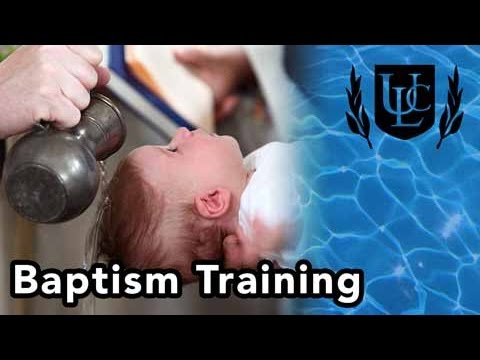How to perform a Baptism

Many Christian denominations—Orthodox, Catholic, Protestant, alike— have historically practiced the rite of baptism. Over time, many other religions outside of Christianity have also adopted the tradition. This ceremony often signals an individual's introduction into the faith. In this sense, baptism is often regarded as one of the most important moments in one's spiritual journey.
This page has been developed to help direct and provide tips for ULC ministers on how to go about performing a baptism. If you'd like more information, we suggest looking into our very popular Baptism Kit. This package includes an expertly crafted guide on performing the spiritual rite of baptisms, several high-quality certificates, and a specialized clergy badge to present to attendees at your next ceremony.
Although each denomination and religion have their own individual practices and traditions , most forms of baptism involve using water to cleanse people of their sins before they enter the faith. This ritual is also considered a way of ushering someone into their new spiritual life. Reverends, pastors and ministers are often looked to as those who perform this ceremony. In fact, many of our ministers have found themselves called upon to perform this special ceremony. If you are in need of a baptism speech, our baptism ceremony script is just the thing for you.
Baptism ceremonies generally come in two forms: immersion and affusion. Immersion baptisms involve fully submerging the person into water. This can be done in a pool, large tub, or in a lake/river. Affusion baptism is a much simpler process. For this type of ceremony, water is simply sprinkled or poured on the person's head. We created the following video to help our ministers better understand the difference between these two types of baptism:
Christian Baptism Ceremonies
In several Christian denominations, baptism ceremonies abide by the Trinitarian formula, which consists of a specific mention of The Holy Trinity: the Father, the Son and the Holy Spirit. This is derived from the biblical passage of Matthew 28; however, other traditions prefer to use a formula derived from Peter in the Book of Acts, which specifically mentions the repentance of sins through baptism in the name of Jesus Christ.
If you have recently been asked to perform a baptism for a person in a specific denomination of Christian faith, we suggest that you research what the traditions of their faith are. As a minister, it's also important to open a dialogue before the ceremony to set expectations and get on the same page.
Step-by-Step guide Performing a Baptism

Compared to certain other ministerial duties, the act of performing a baptism is quite simple. At a minimum, a baptism ceremony consists of two people: the minister conducting the rite and the recipient of the baptism. Of course, friends and family members often attend too. If a baby is being baptized, the parents will usually be a part of the ceremony. Doctrine and script vary for each tradition, but for your consideration, we have compiled this list of basic steps for a baptism ceremony:
- The recipient of the baptism is to be dressed in a white gown or robe. In biblical texts, the color white is usually regarded as representing purity.
- Prayers are recited. The prayers that are typically said during the ceremony are meant to cleanse infants of original sin and adults of any sins they have committed up to that point.
- The recipient of the baptism is supported. Often times, infants are held by their guardians or parents at this point, whereas adult recipients are held by the minister or priest.
- The recipient is cleansed. At this point the minister beings the cleansing process. It is common for adults to either be partially or fully immersed in the water during this cleansing process, while infants might only need a bit of water on their foreheads.
- Following the baptism. Once the ceremony is completed, the recipient is a full-fledged member of the faith. A celebration is often held to commemorate this special event.
Certain denominations use a record keeping process for baptisms that includes dates, times, and names of the people involved. To inquire more about this record keeping system, please check with the specific denomination and your local church. Baptism ceremonies are usually held as a private event in which only the recipient's family and loved ones are present; however, it is not uncommon for the baptism to be held at a larger church gathering. Such details are entirely up to the minister and the recipient's discretion.